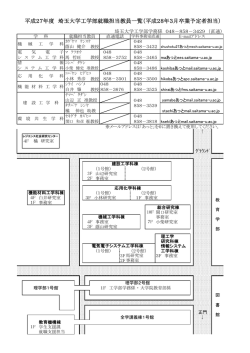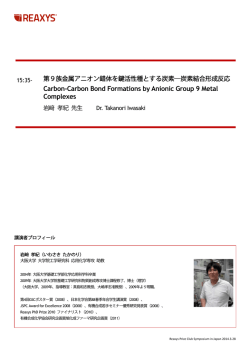
竹内勝彦先生 - Elsevier
16:00- ケイ素-ケイ素三重結合化合物ジシリンとアゾベンゼンとの 反応による Si2N2 四員環ビラジカロイドの合成 Access to a Stable Si2N2 4-Membered Ring with Non-Kekulé Singlet Biradical Character from a Disilyne 竹内 勝彦 先生 Dr. Katsuhiko Takeuchi 講演者プロフィール 竹内 勝彦(たけうち かつひこ) 京都大学 化学研究所 助教 2007年3月 筑波大学 第一学群 自然学類 化学専攻 卒業 2009年3月 筑波大学大学院 数理物質科学研究科 化学専攻 博士前期課程 修了 2012年3月 筑波大学大学院 数理物質科学研究科 化学専攻 博士後期課程 修了 2012年4月∼2012年4月 トロント大学 博士研究員 (JSPS海外特別研究員) 2013年8月∼現在 京都大学 化学研究所 遷移金属錯体化学研究領域 小澤研究室 助教 Reaxys Prize Club Symposium in Japan 2014.3.28 Reaxys Prize Club Symposium in Japan 2014.3.28 ケイ素―ケイ素三重結合化合物ジシリンとアゾベンゼン との反応によるSi2N2四員環ビラジカロイドの合成 Access to a Stable Si2N2 4-Membered Ring with Non-Kekulé Singlet Biradical Character from a Disilyne N Si Si N 竹内 勝彦 京都大学 化学研究所 遷移金属錯体化学研究領域 小澤研究室 Reaxys Prize Club Symposium in Japan, March 28, 2014 Profile 01 2007年 3月 筑波大学 第一学群 自然学類 化学専攻 卒業(関口研究室) 2009年 3月 筑波大学大学院 数理物質科学研究科 化学専攻 博士前期課程 修了(関口研究室) 2012年 3月 筑波大学大学院 数理物質科学研究科 化学専攻 博士後期課程 修了(関口研究室) 2012年 4月 ∼ 2013年 7月 カナダ トロント大学 JSPS海外特別研究員(Stephan研究室) 2013年 8月 ∼ 京都大学 化学研究所 助教(小澤研究室) 1 Reaxys Prize Club Symposium in Japan 2014.3.28 Research 02 1.ケイ素–ケイ素三重結合化合物の反応性 disilyne 2.シリルホスフィンのフラストレイティドルイスペアとしての反応性 + Bulky Bulky Lewis Base Lewis Acid Frustrated Lewis Pair 3.ホスファアルケンを有する多座配位子の研究 tBu N Mes* P N P P Mes* P Mes* tBu Research 03 ケイ素―ケイ素三重結合化合物ジシリンとアゾベンゼン との反応によるSi2N2四員環ビラジカロイドの合成 Ar = 3,5-Me2C6H3 Si2N2 4-membered ring biradicaloid N Si N 2 Si Reaxys Prize Club Symposium in Japan 2014.3.28 Introduction: Disilyne Si 04 Si the first isolable Si=Si double bonded compound disilene West (1981) Me 3Si Me 3Si SiMe3 Si Me 3Si Robert C. West University of Wisconsin–Madison Br Br Si Si Br Br Si SiMe3 SiMe3 SiMe3 Me 3Si 4 KC8 THF Me 3Si Me 3Si Si SiMe3 Si Si Me 3Si Si Me 3Si SiMe3 SiMe3 SiMe3 the first isolable disilyne 1 Sekiguchi (2004) Introduction: Disilyne 05 Isolable Disilynes tBu Me 3Si Me 3Si Me 3Si Si SiMe3 Si Si Me 3Si Si SiMe3 Me 3Si Me 3Si SiMe3 SiMe3 Me 3Si Sekiguchi (2004) Me 3Si Si SiMe3 Si Me 3Si Me 3Si Me 3Si SiMe 3 SiMe3 SiMe3 SiMe3 Sekiguchi (2010) unsymmetrically substituted disilyne Me 3Si SiMe 3 SiMe3 Si Me 3Si SiMe3 Si Si Me 3Si Me 3Si Me 3Si Si SiMe3 C SiMe3 Me 3Si tBu Si Si tBu SiMe3 C SiMe3 SiMe3 Iwamoto, Ishida (2013) the first alkyl substituted disilyne Tokitoh (2008) the first aryl substituted disilyne 3 Reaxys Prize Club Symposium in Japan 2014.3.28 Introduction: Disilyne Si1 06 Si2´ Si1´ Si2 137.44(4)º 2.3698(6) Å 2.0622(9) Å cf. Typical Bond Lengths Si–Si 2.34 ~ 2.37 Å Si=Si 2.14 ~ 2.29 Å Introduction: Disilyne 07 R 160 R R C C Si Si R 140 rmax (pm) p-orbital 120 R 100 R s-orbital 80 R 60 C Si Ge Sn R Pb R Orbital radius of group 14 elements 4 R Reaxys Prize Club Symposium in Japan 2014.3.28 Introduction: Disilyne 08 E (eV) HF/6-31G(d) 5.92 LUMO+1 1.88 1.03 0 –6.69 LUMO –7.10 –10.89 HOMO H C C H HOMO–1 Introduction: Disilyne 09 1) 2,3) or R2NH stereo specific 1) PhC CH R2BH 2,4) disilyne 1 tBuNC Me3SiCN Me 3Si N N C Si Dsi 2iPrSi SiMe3 5) C Si Dsi 2iPrSi Si SiiPrDsi SiiPrDsi 2 NC 6) Si CN 2 1) R. Kinjo, M. Ichinohe, A. Sekiguchi, N. Takagi, M. Sumimoto, and S. Nagase, J. Am. Chem. Soc., 129, 7766 (2007). 2) K. Takeuchi, M. Ikoshi, M. Ichinohe, and A. Sekiguchi, J. Am. Chem. Soc., 132, 930 (2010). 3) K. Takeuchi, M. Ikoshi, M. Ichinohe, and A. Sekiguchi, J. Organomet. Chem., 696, 1156 (2011). 4) K. Takeuchi, M. Ichinohe, and A. Sekiguchi, Organometallics, 30, 2044 (2011). 5) K. Takeuchi, M. Ichinohe, and A. Sekiguchi, J. Am. Chem. Soc., 130, 16848 (2008). Dsi 6) K. Takeuchi, M. Ichinohe, and A. Sekiguchi, J. Am. Chem. Soc., 134, 2954 (2012). 5 = CH(SiMe3)2 Reaxys Prize Club Symposium in Japan 2014.3.28 Introduction: Biradicaloid 10 Biradicals pair of doublet monoradicals singlet biradical triplet biradical biradicaloid Cyclicbiradicaloids Niecke (1995) Bertrand (2002) Power (2004) Mes* = 1,3,5-tBu3C6H2 Lappert (2004) Ar* = C6H3-2,6-(C6H3-2,6-iPr2)2 Reaction with Azobenzenes 11 Ar = 3,5-Me2C6H3 THF r.t. / in dark 1 day disilyne 1 THF r.t. / in dark <5 min Si2N2 4-membered ring biradicaloid 2 purple crystals (y. = 58%) 1) cf. Power s Work hexane E = Ge, Sn Ar* = C6H3-2,6-(C6H3-2,6-iPr2)2 1) C. Cui, M. M. Olmsted, J. C. Fettinger, G. H. Spikes, and P. P. Power, J. Am. Chem. Soc., 127, 17530 (2005). 6 Reaxys Prize Club Symposium in Japan 2014.3.28 Possible Reaction Mechanism 12 Ar N–N cleavage π* LUMO SiiPrDsi 2 N Si Si Dsi 2iPrSi N Ar Ar N Ar SiiPrDsi 2 N Si Si Si=Si cleavage Dsi 2iPrSi cf. Reaction with 2-Butene 1) ‡ 1 day disilyne 1 or 30 min hexane 1) R. Kinjo, M. Ichinohe, A. Sekiguchi, N. Takagi, M. Sumimoto, and S. Nagase, J. Am. Chem. Soc., 129, 7766 (2007). Possible Reaction Mechanism 12 Ar π* LUMO N–N cleavage SiiPrDsi 2 N Si Si Dsi 2iPrSi N Ar Ar N Ar SiiPrDsi 2 N Si Si Dsi 2iPrSi Si=Si cleavage B3LYP/6-31G(d) 2' cyclobutene-2' butadiene-2' bis(silylene)-2' 0.0 kcal/mol +43.6 kcal/mol +29.9 kcal/mol not found 7 Reaxys Prize Club Symposium in Japan 2014.3.28 Molecular Structure of Biradicaloid 2 a purple crystal from THF C1 13 1.758(3) 2.4658(15) 2.618(2) N1 Si2 Si1' Si1 1.756(3) Si2' N1' C1' Monoclinic C2/c Z=4 R1 = 0.0394 [I>2σ(I)] wR2 = 0.1193 [All Data] GOF = 1.032 Σ(Si1) = 318º Σ(N1) = 360º in Å sum of the internal angles of the ring = 360º Figure 1. ORTEP drawing and selected structural parameters of 2. cf. Related Compounds 1) 2) 3) Σ(Ge) = 322º Σ(Sn) = 256º Si–Si = 2.697 Å 1) C. Cui, M. M. Olmsted, and P. P. Power, J. Am. Chem. Soc., 126, 6510 (2004). 2) H. Cox, P. B. Hitchcock, M. F. Lappert, and L. J.-M. Pierssens, Angew. Chem., Int. Ed., 43, 4500 (2004). 3) N. Wiberg, H. Schuster, A. Simon, and K. Peters, Angew. Chem., Int. Ed., 25, 79 (1986). AIM Analysis of Biradicaloid 2 14 N 2' Si 2 (Ar = 3,5-Me2C6H3) Si N calc (exp) Si–N 1.785 Å (1.757 Å) Si···Si 2.651 Å (2.618 Å) Σ(Siring) 304º (318º) Σ(Nring) 360º (360º) Bond Critical Point Figure 1. Optimized structure and bond paths of the model compound 2'. B3LYP/6-31G(d) 8 Reaxys Prize Club Symposium in Japan 2014.3.28 NMR Studies of Biradicaloid 2 15 skeletal Si δ 19.4 (Me3Si)2CH (Me3Si)2CH δ 1.0, –0.3 2 (Ar = 3,5-Me2C6H3) iPrSi Dsi2 (Me3Si)2CH Me Ar 2 4 [ppm] 6 8 δ 10.4 iPr 0 50 Figure 1. 1H NMR spectrum of 2 in THF-d8. 25 0 [ppm] –25 –50 Figure 2. 29Si NMR spectrum of 2 in THF-d8. cf. Theoretical Studies GIAO/B3LYP6-311G(3d)//B3LYP6-31G(d) 2' (singlet) 2' (triplet) planar-2' (TS) 0.0 kcal/mol δ(skeletal Si) 14.7 +12.8 kcal/mol +36.8 kcal/mol δ(skeletal Si) 52.3 UV-Vis Spectrum of Biradicaloid 2 16 [eV] –0.38 60000 0.02 529 nm [ε = 32000] 40000 LUMO+1 (σ* orbital of Si2N2 ring) –2.39 [f ] LUMO [ε] –4.60 0.01 20000 b 356 nm [ε = 4300] HOMO a –5.33 c 0 200 0.00 400 [nm] 600 800 HOMO–1 –8.98 TDDFT Calculation transition a: 515 nm (f = 0.0115) HOMO–1 → LUMO HOMO–12 transition b: 514 nm (f = 0.0123) HOMO → LUMO 6π aromaticity? transition c: 367 nm (f = 0.0016) HOMO → LUMO+1 B3LYP/6-31G(d) 2' Figure 1. UV-Vis spectrum of 2 in hexane superimposed by the calculated band position of 2' (left) and MOs of 2' (right) . 9 Reaxys Prize Club Symposium in Japan 2014.3.28 Aromaticity of Biradicaloid 2 17 in Å 1.7479(14) 1.758(3) 2.618(2) 2.5889(8) 1.756(3) 1.7536(13) Σ(Si1) = 318º Σ(N1) = 360º Σ(Si1)except Cl1 = 325º Σ(N1) = 360º sum of the internal angles of the ring = 360º sum of the internal angles of the ring = 360º Figure 1. Selected structural parameters of biradicaloid 2 (left) and Cl2-adduct 4 (right). cf. NICS Values of Model Compounds 2' NICS(1) = –4.2 4' NICS(1) = –2.1 B3LYP/6-31G(d) Reactivity of Biradicaloid 2 18 MeOH (excess) + THF r.t. / 1 h cis-3 (y. = 65%) trans-3 closed-shell reactivity 2 Ar = 3,5-Me2C6H3 O1 N1 Si1 N2 Si2 Figure 1. ORTEP drawing of cis-3. cf. intra- or inter-molecular H+ transfer LUMO of 2 10 cis- or trans-3 Reaxys Prize Club Symposium in Japan 2014.3.28 Reactivity of Biradicaloid 2 19 MeOH (excess) + THF r.t. / 1 h cis-3 (y. = 65%) trans-3 closed-shell reactivity CCl4 (excess) 2 Ar = 3,5-Me2C6H3 N1 Si1 THF r.t. / 20 min Cl1' Si1' Cl1 N1' 4 (y. = 55%) radical-type reactivity Figure 1. ORTEP drawing of 4. cf. Reactivity of Silyl Radical No Reaction MeOH CCl4 Summary 20 Ar = 3,5-Me2C6H3 disilyne 1 2 • Si2N2 4-membered ring 2 was synthesized by the reaction of disilyne 1 with azobenzen • NMR data of 2 suggest that 2 has a singlet ground state. • Theoretical calculations show no bonding interaction between the skeletal Si atoms of 2. • Although 2 has 6π-electrons in the 4-membered ring, the NICS value indicates small aromaticity. • Reactions of 2 with MeOH and CCl4 show that 2 has both closed-shell and radical-type reactivity. 11 Reaxys Prize Club Symposium in Japan 2014.3.28 Acknowledgment 21 University of Tsukuba Prof. Dr. Akira Sekiguchi A/Prof. Dr. Masaaki Ichinohe Dr. Vladimir Ya. Lee Dr. Masaaki Nakamoto and all members of Sekiguchi, Stephan, and Ozawa groups! University of Toronto Prof. Dr. Doug W. Stephan Kyoto University Prof. Dr. Fumiyuki Ozawa Dr. Masayuki Wakioka 12
© Copyright 2026


